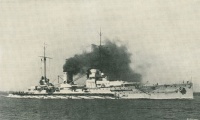Battle cruiser that played a pivotal diplomatic role
“A very successful design worthy of close attention for its divergence from a British practice of centreline turrets”.

The German battle cruiser Goeben was one of the fastest and most powerful warships of its day. Manned by more than 1,000 crewmen, it played a pivotal role in influencing Turkey to enter the First World War on the side of the Central Powers.
According to The Engineer’s 1912 archive, Goeben was an example of ’a very successful design and one which is worthy of close attention in view of its wide divergence from the British practice of centreline turrets and lack of heavy secondary armament’.
The ship was 610ft in length and could displace 22,600 tons. Its armament consisted of 10 11in, 45-calibre guns placed in five turrets, an armoured battery of 12 6in guns on the main deck and an anti-torpedo boat armament of 12 3.4in guns distributed forward and aft of the ship.
The Engineer described a chart house design, which it considered to be too low. ’From the lower bridge it is impossible to see aft… The general arrangement round the forward funnel does not appear to be very good, but this defect is by no means confined to the Goeben.’
Register now to continue reading
Thanks for visiting The Engineer. You’ve now reached your monthly limit of premium content. Register for free to unlock unlimited access to all of our premium content, as well as the latest technology news, industry opinion and special reports.
Benefits of registering
-
In-depth insights and coverage of key emerging trends
-
Unrestricted access to special reports throughout the year
-
Daily technology news delivered straight to your inbox










Water Sector Talent Exodus Could Cripple The Sector
Maybe if things are essential for the running of a country and we want to pay a fair price we should be running these utilities on a not for profit...